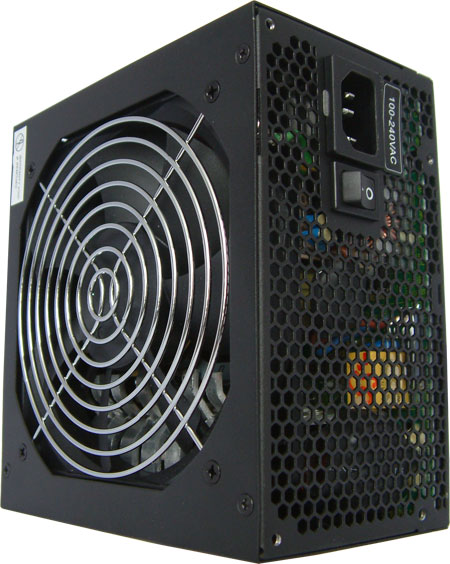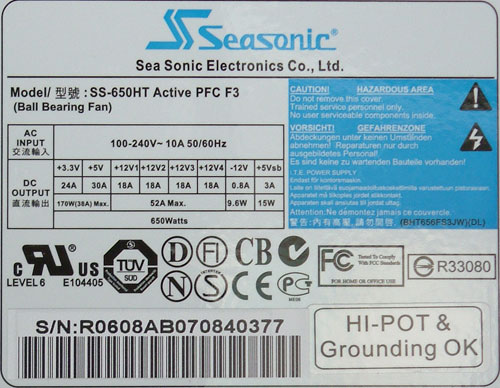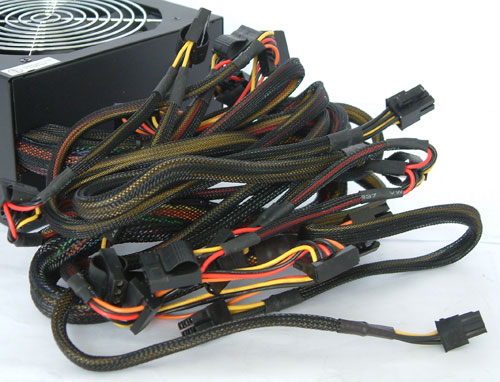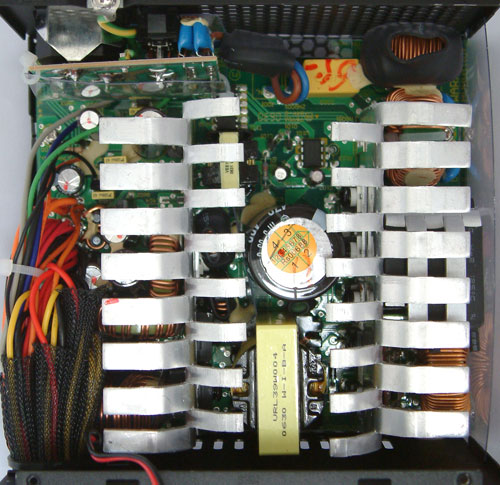Power Supply Roundup: 650W-680W
by Christoph Katzer on February 21, 2008 2:00 AM EST- Posted in
- Cases/Cooling/PSUs
Seasonic
Energy Plus SS-650HT

As one of the pioneers of the modern "planet saving movement", Seasonic's 650HT is a very aged power supply. Still, as stated Seasonic was one of the first companies to design energy efficient topologies, and they've earned respect from users all over the world. Coming in a standard black color with a silver fan grill, this unit doesn't look all that special, but that's Seasonic's modus operandi, and it has helped make them famous. Their first retail power supply - the Super Tornado in 2002 - came in plain grey in a day when colorful power supplies were all the rage. Seasonic ignored the fads and instead focused on high efficiency and high reliability for their products. The 650HT was one such product, first released a few years ago. Since many own these power supplies (or variations of this power supply), we felt including it in this roundup made sense.

Looking at the Seasonic label we see four 12V rails rated at 18A, with a total combined power of 52A. Recognize the pattern yet? The 3.3V and 5V rails both have the standard amperage and 170W combined power.

Being a little bit behind the current market trends has been a common feature of Seasonic, but since this fellow is already over a year old we won't criticize it for only including two 6-pin PEG connectors; besides, that's standard practice in the 650W range as we can see from the competition today. All cables are nicely sleeved with a decent length. Seasonic doesn't try to be different from the crowd, and the cables come with standard lengths of at least 50cm.

The inside is nice and sleek. Compared to the be quiet! power supply, the Seasonic Energy Plus seems empty and comes in a very short and compact case. Look closer and you can see that this design is also used in the PC Power & Cooling Silencer, though PC Power added components to the primary side. Seasonic also uses a 120mm fan, which is the major difference from some of their OEMs. The heatsinks need to let some air through, and Seasonic uses a standard heatsink design of a simple plate cut and bent into shape. It's one of the cheapest methods of producing heatsinks since the tooling costs of an extruded heatsinks are quite high, but Seasonic doesn't have a problem with high temperatures and this type of heatsink is sufficient for their needs. Channel Well also uses this method for some of their power supplies, but they don't leave enough space between the fins to let air through.










23 Comments
View All Comments
larson0699 - Monday, August 4, 2008 - link
You mentioned that the label on the Thermaltake unit doesn't state maximum combined load of the lower-volt rails.But look, it does. 180 Watts.
BRDiger - Tuesday, July 29, 2008 - link
I kind a wondering because comparing the efficiency level of the Be Quiet! to the testing datasheet on the 80plus.org site it just reaches about 80% at 100% load unlike your results with nearly 84%. Comparing it to the Enermax Modu 82+ review here, it even exeeds its efficiencyJust wondering and it´s not supposed to be an offence...
BRDiger - Tuesday, July 29, 2008 - link
Well, after reading another review it seems that 80plus was actually wrong and the be quiet!s performance exeeds the enermax..strikeback03 - Friday, February 22, 2008 - link
Thermal and fluids was not my best subject in school, but don't fans usually lose air off the tips of the blades, not suck it in? That is my experience with the Zerotherm Nirvana, which seems to make the same claim of sucking air in with its open fan.mo3 - Friday, February 22, 2008 - link
The new Enermax Modular 82+ & Pro 82+ can peak over 700Watts with out a problem; also they have the ATX12v V2.3 and reaching 88% efficiency.Modular 82+ has 2x 12 pin connection embedded for up and coming graphics cards and greater stability.
Just to give the readers a better alternative! :)
Check out more info at: www.enermax.co.uk
crimson117 - Friday, February 22, 2008 - link
Okay... PSU review.. new 9600 GT review... I think anandtech is trying to tell me I need a new computer!NINaudio - Thursday, February 21, 2008 - link
Hi, you mention that the be quiet! PSU is quiet but also runs warmer than the others. Where are the temperature charts that we've seen in previous PSU reviews? It would be good to see the temperatures that you sacrifice for a quieter PSU. Is it a degree, 5 degrees, ten degrees, more?tynopik - Thursday, February 21, 2008 - link
1. include a real stress test like how the units handle rapidly changing input voltagesay load them up to 80% capacity and then connect them to a variac and dip the voltage to ~90V 3 times in quick succession to simulate a brownout or poor electrical conditions and check that
a) it doesn't blow up
b) it maintains quality output while the input if fluctuating
2. include cheapo units for comparision just for the reminder of what a poor quality unit is
3. i really love your connector length charts, far more useful than the usual 'stetch a jumble of cables out and lay a ruler next to it' approach. i just wish you would do the same for the sata/peripheral connectors
4. i'm really like the way you combined all the acoustic and efficiency charts together instead of having a bunch of individual charts
Christoph Katzer - Thursday, February 21, 2008 - link
I just assembled a nice system do to those tests. Once it's up and running I will include it. Will also make a comparison of all cables from now on, thanks.The problem with cheap units is that they are mostly for a specific market. I would need to buy thise units myself since no company would ever send them over. Since I am not in the US I will only have the stuff from Europe which is not even available in the US. But let us see how we could change that in the future...
jtleon - Thursday, February 21, 2008 - link
Chris,You state that at least 100W must be drawn before these units achieve high efficiency. Can you relate this requirement to most normal PC tasks - i.e. browsing the web (reading Anandtech reports of course), answering email, other office based activities (the majority of PC users on the planet), rather than those hardcore gamers that are gaming around the clock (and clearly are independently wealthy!).
It would appear that these PSU's are not going to efficiently reduce the carbon footprint of the majority of PC users on this planet.
Am I wrong?
Regards,
jtleon